Key takeaways
- A musician portfolio is a personal showcase that highlights artistic journey, skills, and emotional connections with the audience.
- Documenting performances fosters growth, engagement with fans, and provides promotional material.
- High-quality tools for capturing live moments, both audio and visual, enhance the authenticity of performance documentation.
- Key lessons from performances include the importance of preparation, audience connection, and embracing vulnerability for impactful music moments.
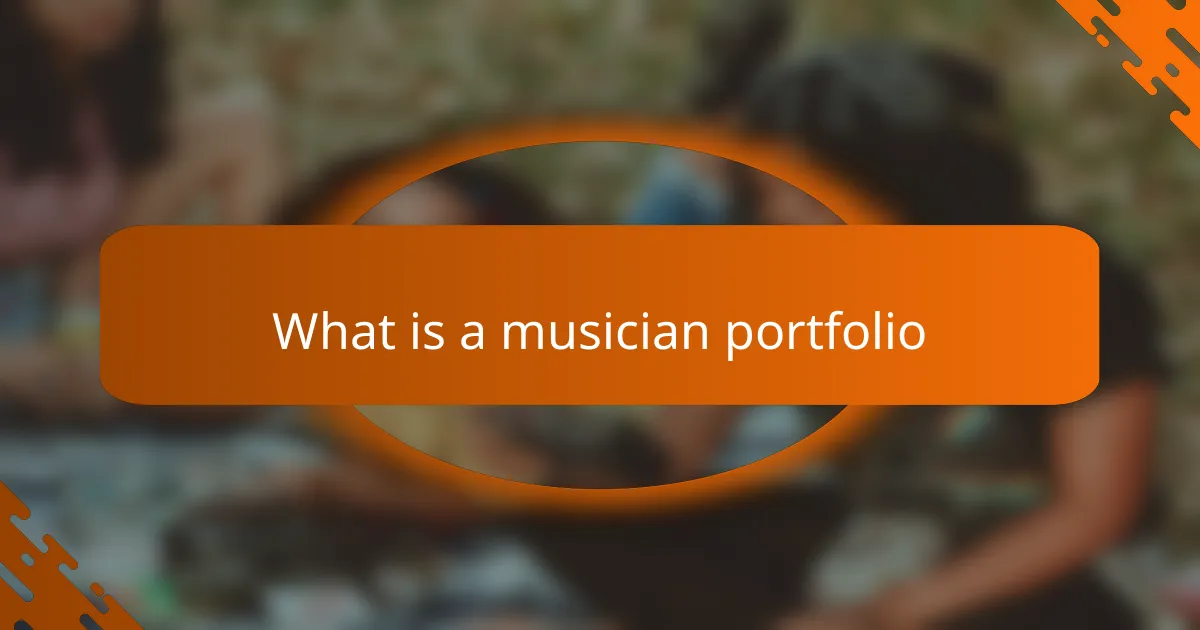
What Is a Musician Portfolio
A musician portfolio is your personal showcase, an essential tool that highlights your artistic journey and skills. When I created mine, I aimed to capture not just my performances but the essence of who I am as a musician. Each piece included, whether a video, audio clip, or written reflection, tells a story about my growth and passion for music.
In my experience, a well-curated portfolio can differentiate you in a competitive field. It’s not just about listing accomplishments; it’s about connecting with your audience on an emotional level. I fondly remember how a particular recording of mine, showcased in my portfolio, resonated deeply with listeners—reminding me of the power of music to transcend mere notes and rhythms.
Here’s a quick comparison of different elements typically found in musician portfolios:
| Element | Description |
|---|---|
| Audio Samples | High-quality recordings showcasing your range and style. |
| Video Performances | Visual content that captures your stage presence and interaction with the audience. |
| Written Reflections | Personal anecdotes and insights that illustrate your journey and influences. |
| Resume | A concise overview of your educational background, performances, and accolades. |
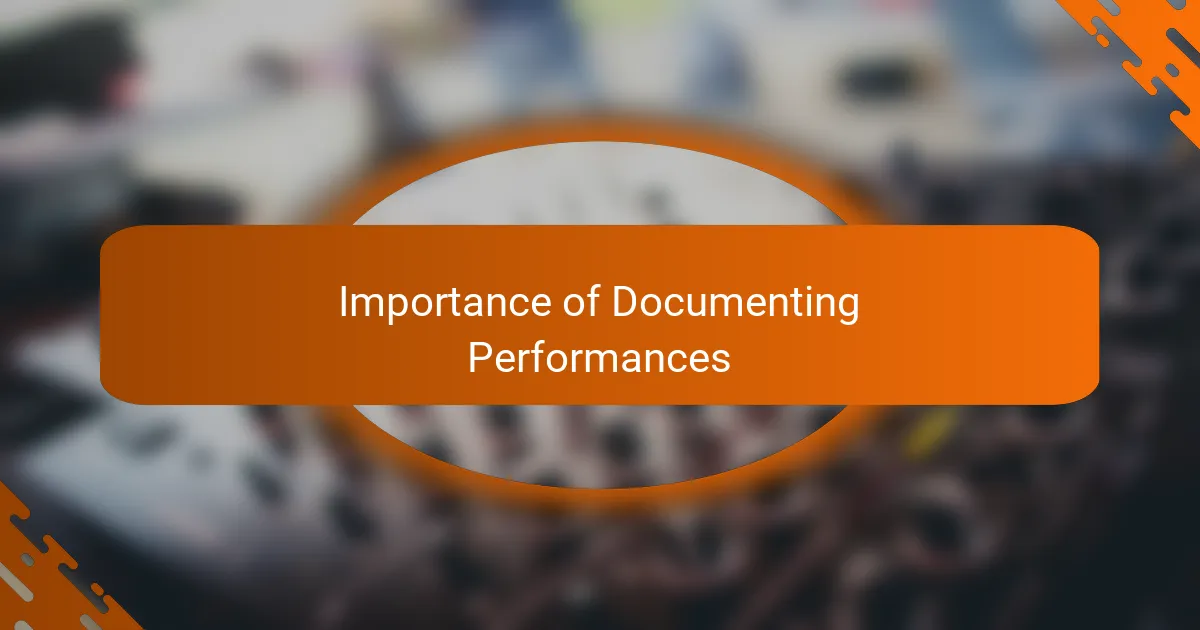
Importance of Documenting Performances
Documenting performances is crucial for musicians, as it allows us to reflect on our growth and artistry. I remember the rush of adrenaline during my first performance at Carnegie Hall. Capturing that night through photos and videos not only preserved the memory but also marked a pivotal moment in my career. Looking back at those recordings, I can see how much I’ve evolved as a musician.
Moreover, having a rich archive of performances creates opportunities for engagement with audiences and potential collaborators. By sharing these moments, I can connect with fans and showcase my journey, making the music more relatable.
- Provides a tangible record of artistry and development.
- Offers material for promotional purposes, like social media, websites, and press kits.
- Facilitates self-reflection and personal growth through review.
- Helps build a community by sharing experiences with fans.
- Serves as a legacy for future generations to appreciate and learn from.
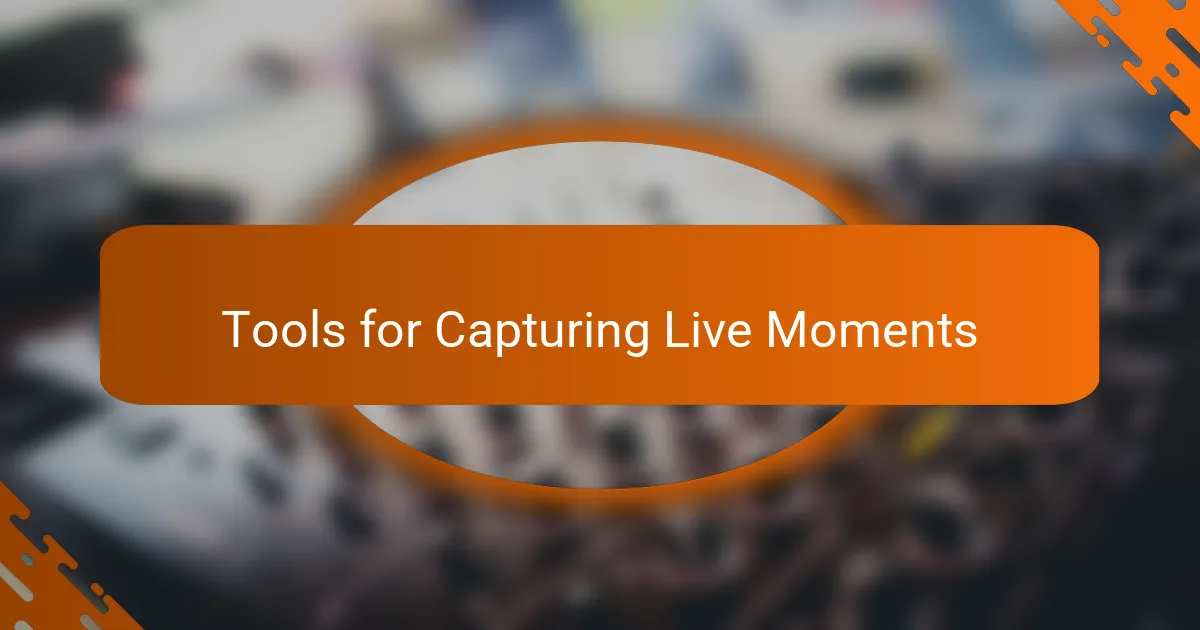
Tools for Capturing Live Moments
Capturing live moments requires the right tools, and my experiences have taught me what truly makes a difference. I’ve relied heavily on high-quality audio recorders, as they pick up the nuances of performance that can get lost in lower-quality devices. I remember one concert where the subtle vibrato in my voice translated beautifully in a recording, allowing listeners to feel that emotional connection across distances.
For visual documentation, a good DSLR camera stands out. During my time at Carnegie Hall, I made sure to have a reliable photographer with a fast lens. It was incredible to see the candid shots that captured both my excitement and the audience’s reaction, creating a visual story that words alone couldn’t convey. This reminded me that images can speak volumes about the energy of a live performance.
And let’s not overlook the power of smartphones. They may not rival professional equipment, but their convenience allows us to capture moments spontaneously. I still treasure a quick video I recorded backstage, sharing some behind-the-scenes excitement with fans. It serves as a great reminder that sometimes the most authentic moments come from unexpected places.
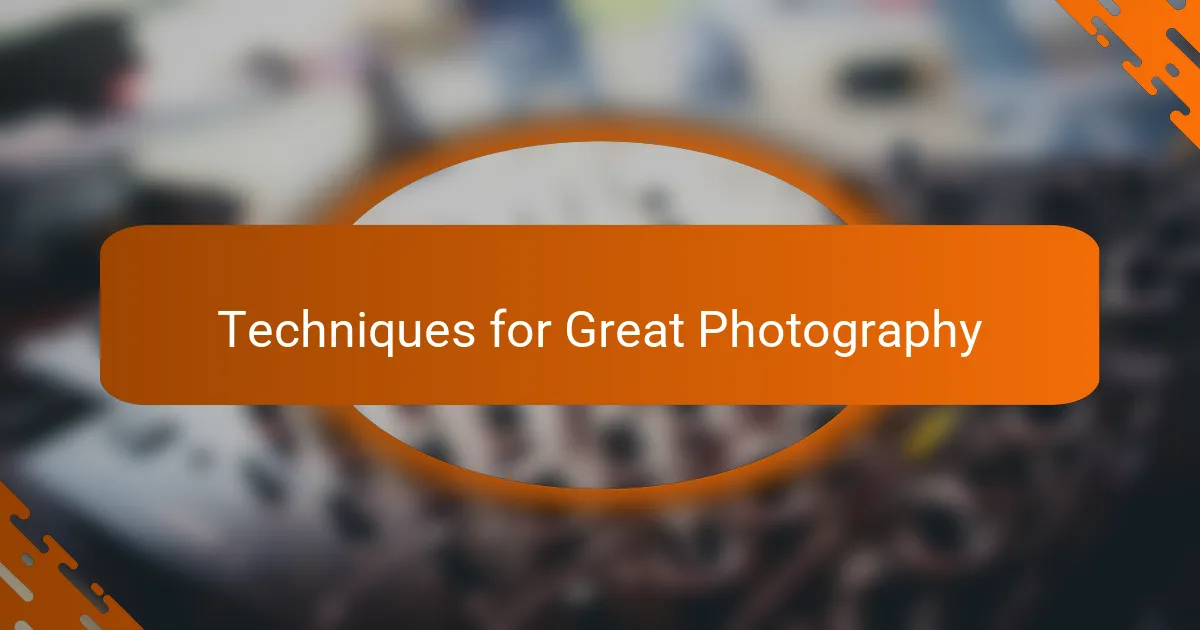
Techniques for Great Photography
To capture great photos, understanding lighting is critical. I learned this firsthand during a performance when the stage lighting shifted dramatically. It took some adjustment on my part, but those moments of softer light created an intimate atmosphere that added depth to my photos. Have you ever noticed how certain shadows can evoke emotion in a picture? It’s those delicate contrasts that often tell a story.
Composing your shot plays a vital role as well. On one occasion, I experimented with different angles while photographing my band rehearsing. I discovered that framing the musicians with the city skyline behind us created a powerful backdrop that connected our art to the world around us. Do you think about how the environment influences your images? Trust me, the context can elevate a simple snapshot into a visual masterpiece.
Finally, don’t underestimate the value of candid shots. Some of my favorite photos were taken when I wasn’t even posing. There’s something authentic about those unscripted moments—like when I caught a fellow musician lost in concentration during a rehearsal. Those images, filled with raw emotion, encapsulate the passion we all have for music. How do you capture real moments in your work? Remember, it’s often in the unexpected that the most beautiful memories are made.
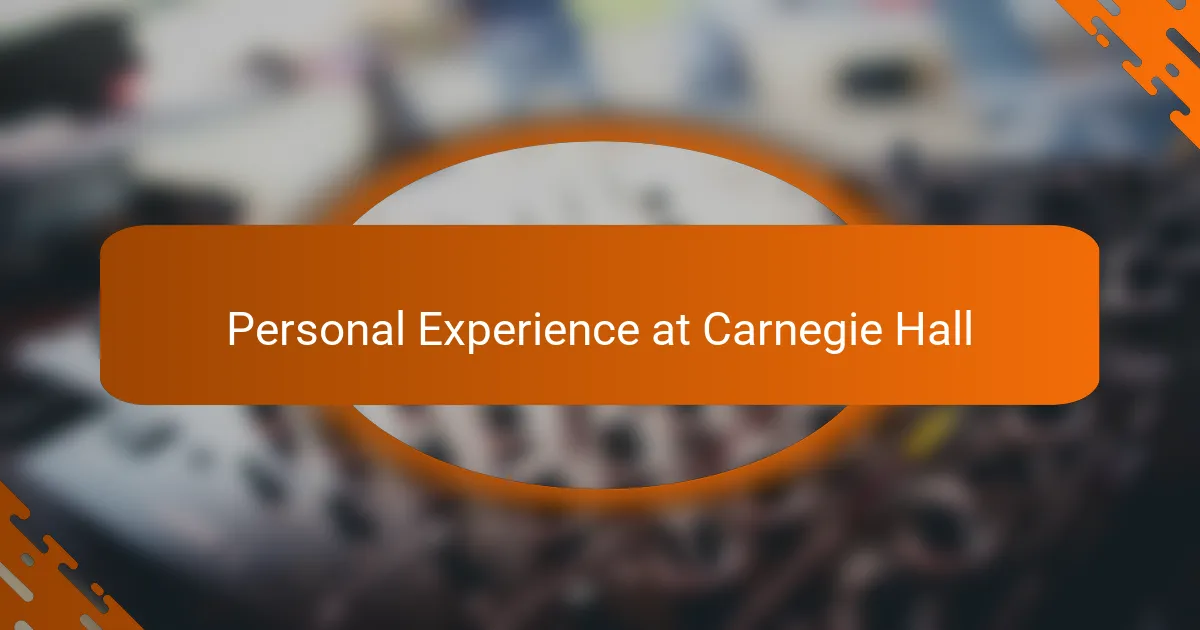
Personal Experience at Carnegie Hall
Stepping onto the stage of Carnegie Hall was a surreal experience for me. I vividly recall the moment the lights dimmed, I took a deep breath, and my heart raced with anticipation. As I stood in front of the audience, I could feel the energy in the room, an electric connection that seemed to bind us all together. Have you ever felt such a potent mix of excitement and nervousness before a big moment? It’s an unforgettable rush.
During my performance, I immersed myself in the music, losing track of time and self. I still remember the way the notes floated into the air, each one a piece of my soul shared with those listening. After the final bow, the applause echoed for what felt like an eternity, a sweet affirmation that made the entire journey worthwhile. Looking back, I understand now how vital it is to share such emotions through documentation. How do you encapsulate a moment that felt so monumental?
In the days that followed, as I sifted through the photographs and recordings, I was struck by how those images captured not just the performance, but the passion, the joy, and even the brief moments of calm in between. Seeing the audience’s reactions and the expressions of my fellow musicians reminded me that music is a collective experience, not just an individual one. Often, it’s those little details—the genuine smiles and heartfelt claps—that create the essence of our artistry. How do you reflect on and share your own music experiences?
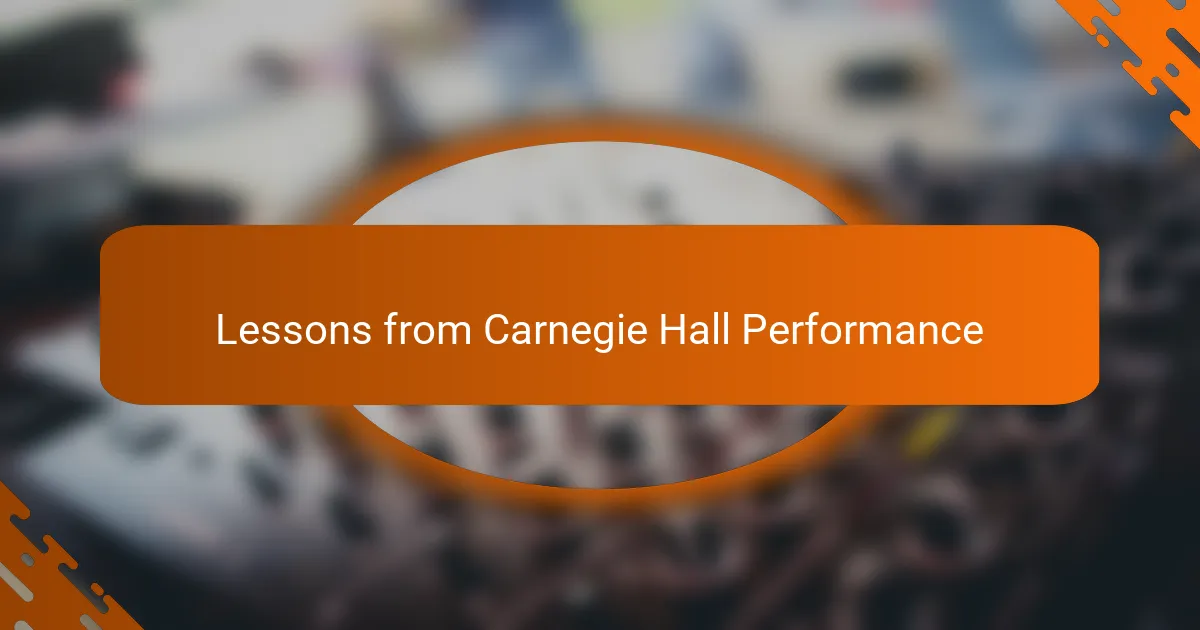
Lessons from Carnegie Hall Performance
The Carnegie Hall performance was truly a lesson in the power of preparation and connection. I learned that every note I played was amplified by the energy of the audience; their reactions inspired me to dig deeper into my performance. The experience taught me the importance of being present in the moment, where every heartbeat aligns with the music.
From this performance, I also discovered that vulnerability can be a source of strength. I remember feeling a wave of nervousness wash over me just before stepping on stage. Yet, as I embraced that anxiety, it transformed into passion that resonated through my music.
| Lesson | Insights |
|---|---|
| Preparation | Every detail matters; it sets the foundation for a great performance. |
| Connection | The energy from the audience enhances every musical moment. |
| Vulnerability | Embracing anxiety can lead to a powerful and passionate performance. |